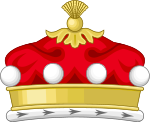Edward Pearce, Baron Pearce
The Lord Pearce | |
|---|---|
 | |
| Lord of Appeal in Ordinary | |
| In office 1962–1969 | |
| Personal details | |
| Born | 9 February 1901 Sidcup,KentEngland |
| Died | 26 November 1990(aged 89) |
Edward Holroyd Pearce, Baron Pearce,PC(9 February 1901 – 26 November 1990) was a British barrister and judge. He served as aLord of Appeal in Ordinaryfrom 1962 until 1969. In 1971–72, he chaired thePearce Commission,which was charged with testing the acceptability of a proposed constitutional settlement inRhodesia.[1][2]
Early life and career
[edit]Edward Holroyd Pearce was born inSidcupinKent,the eldest child (he was followed by three sisters) of John William Ernest Pearce, headmaster of a preparatory school, and Irene Pearce,néeChaplin, daughter of daughter of Holroyd Chaplin.[1]He was educated atCharterhouse SchoolandCorpus Christi College, Oxford,of which he was ascholarand where he took aFirstinHonour Moderationsin 1921 and aThirdinliterae humanioresin 1923. He was elected an honoraryfellowof Corpus Christi in 1950.[1][2]
Called to the barbyLincoln's Innand theMiddle Templein 1925, he practiced in theKing's BenchandProbate, Divorce and Admiralty Divisionsof theHigh Court.In the 1930s, Pearce was forced to leave legal practice for a time because of tuberculosis. He spent some time inSwitzerland,where he acquired a lifelong passion for oil painting, before returning to the Bar. He later exhibited regularly at theRoyal Academyand mounted one-man exhibitions as well, sometimes also exhibiting together with his wife, a watercolourist.[1][2]He became a member of theRoyal Society of British Artistsin 1940.[2]
Exempt from military service on medical grounds, Pearce continued to practice at the bar during the Second World War; he was appointedKing's Counselin 1945.[1][2][3]He became deputy chairman of the East SussexQuarter Sessionsin 1947, was elected a bencher ofLincoln's Innin 1948 and served as its treasurer in 1966.[1][2][4]
Judicial career
[edit]On 14 October 1948, Pearce was appointed aJustice of the High Court,receiving the customaryknighthoodon 29 October.[1][2][5][6]He was initially assigned to theProbate, Divorce and Admiralty Division,before being transferred to theQueen's Bench Divisionin 1954.[1][2]He was made aLord Justice of Appealon 30 April 1957, and sworn of thePrivy Council.On 19 April 1962, Pearce was madeLord of Appeal in Ordinaryand was created alife peerwith the titleBaron Pearce,of Sweethaws in the County ofSussex.[1][2][7]
In his capacity as a member of theJudicial Committee of the Privy Council,Pearce sat on the case ofMadzimbamuto v Lardner-Burke,concerning the constitutionality ofRhodesia's Unilateral Declaration of Independence.He dissented from the majority decision ofLord Reid,who held that the Unilateral Declaration was unconstitutional and the detention orders in issue were therefore unlawful. While agreeing that the Declaration was unlawful, Pearce would have held that the detention orders in issue were lawful, on the basis that they had been issued by a government which was inde factocontrol of Rhodesia, and therefore should be applied by the courts.[8]
He retired as Lord of Appeal in Ordinary in 1969.
Post-judicial career and later life
[edit]After his retirement from the bench, Lord Pearce became chairman of thePress Councilin 1969, serving until 1974. From 1969 until 1976, he was chairman of the Appeals Committee of theTakeover Panel.
In 1971–72, he chaired a commission (known as thePearce Commission) tasked with testing the acceptability of a proposed constitutional settlement in Rhodesia negotiated betweenSir Alec Douglas-HomeandIan Smith.The four-person commission reported in May 1972: it described white, coloured and Asian Rhodesians as in favour of the terms by 98%, 97% and 96% respectively, and black citizens as against them by an unspecified large majority. As a result, the proposals were shelved, though not immediately abandoned.
In his later years Lord Pearce suffered from hip problems. Shortly before his death, he auctioned a sculpture, which he had acquired for £7 in 1951, atSotheby's.The work, identified as a sculpture byAdriaen de Vries,was sold for £6.82 million.
Family
[edit]In 1927, he married Erica Priestman (d. 1985), daughter ofBertram Priestman,RA.They had two sons, James and Bruce, both of whom becameQCs(the eldest also becoming acircuit judge) and predeceased him.[2]
Selected judgments
[edit]- Long v Lloyd[1958] 1 WLR 753
- McCutcheon v David MacBrayne Ltd[1964] 1 WLR 125
- Madzimbamuto v Lardner-Burke[1969] 1 AC 645
- Anisminic v Foreign Compensation Commission[1969] 2 AC 147
Arms
[edit]  |
|
References
[edit]- ^abcdefghiComyn, James."Pearce, Edward Holroyd, Baron Pearce".Oxford Dictionary of National Biography(online ed.). Oxford University Press.doi:10.1093/ref:odnb/40093.(Subscription orUK public library membershiprequired.)
- ^abcdefghij"Lord Pearce".The Times.28 November 1990. p. 20.
- ^"No. 37160".The London Gazette.3 July 1945. p. 3463.
- ^"No. 38100".The London Gazette.17 October 1947. p. 4882.
- ^"No. 38431".The London Gazette.15 October 1948. p. 5445.
- ^"No. 38447".The London Gazette.2 November 1948. p. 5789.
- ^"No. 42654".The London Gazette.20 April 1962. p. 3276.
- ^Madzimbamuto v Lardner-Burke,[1968] UKPC 18;[1968] 3 WLR 1229; [1968] 3 All ER 561; [1969] 1 AC 645.
- ^"Lincoln's Inn Great Hall, Nb23 Pearce, EH (knight's panel)".Baz Manning. 18 October 2015.Retrieved19 December2020.
- "family.ray-jones.org.uk".Retrieved12 January2007.
External links
[edit]- 1901 births
- 1990 deaths
- Alumni of Corpus Christi College, Oxford
- Law lords
- Members of Lincoln's Inn
- Members of the Middle Temple
- Members of the Privy Council of the United Kingdom
- People educated at Charterhouse School
- Members of the Judicial Committee of the Privy Council
- People from Sidcup
- 20th-century British judges
- Knights Bachelor
- Probate, Divorce and Admiralty Division judges
- Queen's Bench Division judges
- English painters
- English King's Counsel
- 20th-century King's Counsel
- 20th-century English lawyers
